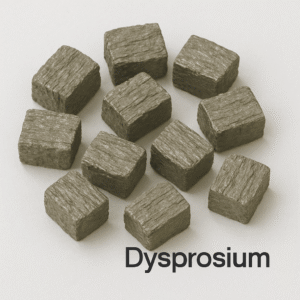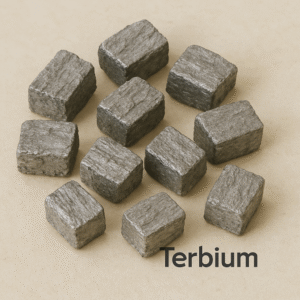Your cart is currently empty!
Praseodymium (Pr)
Basic Information Element Name: Praseodymium Symbol: Pr Atomic Number: 59 Atomic Weight: 140.91 Element Category: Lanthanide (Rare Earth Element) Standard State: Solid Appearance: Silvery-white, soft, malleable metal that quickly oxidizes in air Chemical and Physical Properties Density: 6.77 g/cm³ Melting Point: 931 °C (1,708 °F) Boiling Point: 3,120 °C (5,648 °F) Electronegativity (Pauling scale): 1.13 Common Oxidation States: +3 […]
Description
Basic Information
-
Element Name: Praseodymium
-
Symbol: Pr
-
Atomic Number: 59
-
Atomic Weight: 140.91
-
Element Category: Lanthanide (Rare Earth Element)
-
Standard State: Solid
-
Appearance: Silvery-white, soft, malleable metal that quickly oxidizes in air
Chemical and Physical Properties
-
Density: 6.77 g/cm³
-
Melting Point: 931 °C (1,708 °F)
-
Boiling Point: 3,120 °C (5,648 °F)
-
Electronegativity (Pauling scale): 1.13
-
Common Oxidation States: +3 (dominant), +4 (rare)
-
Magnetism: Paramagnetic
-
Special Feature: Forms a green oxide coating (Pr₆O₁₁) when exposed to air
Reactivity and Storage
Praseodymium is reactive, especially with oxygen and moisture. It forms a green oxide layer that partially protects the metal from further corrosion. For safe storage, it should be kept under mineral oil or an inert atmosphere (argon/nitrogen).
Occurrence and Extraction
Praseodymium is naturally found in minerals such as monazite and bastnäsite, typically mixed with other lanthanides. It is isolated via solvent extraction, ion exchange, or metallothermic reduction methods.
Isotopes
-
Natural praseodymium consists of one stable isotope: Pr-141
-
Several synthetic radioactive isotopes exist for nuclear and research applications
Key Applications
1. High-Strength Magnets (NdFeB Magnets with Pr Substitution)
-
Praseodymium is alloyed with neodymium in NdFeB magnets to enhance magnetic strength and temperature stability
-
Used in:
-
Electric vehicle motors
-
Wind turbines
-
Computer hard drives
-
Robotics and aerospace actuators
-
2. Glass and Ceramic Colorants
-
Praseodymium compounds, especially praseodymium oxide (Pr₆O₁₁), impart a green to yellow color
-
Used in coloring high-quality glass, ceramics, and enamels
-
Also acts as a UV light filter in protective glass
-
3. Optical and Laser Materials
-
Pr³⁺-doped crystals are used in solid-state lasers and fiber optics
-
Emit light in the visible and near-infrared range
-
Applications include: display technology, medical lasers, and spectroscopy
-
4. Alloying Agent in High-Performance Metals
-
Praseodymium is added to magnesium alloys to improve strength and corrosion resistance
-
Used in aerospace, jet engine components, and high-end structural materials
-
5. Carbon Arc Lighting
-
Historically used in carbon arc electrodes for motion picture projectors and stage lighting
-
Still applied in specialty lighting technologies
-
Strategic Relevance
-
Praseodymium is considered a critical raw material due to its essential role in clean energy (EVs, turbines), defense, and electronics
-
Global supply is geographically concentrated, making it vulnerable to market fluctuations
-
Recycling and substitution programs are underway to reduce long-term dependency
Interesting Facts
-
Discovered in 1885 by Austrian chemist Carl Auer von Welsbach
-
Name derived from the Greek prasios (green) and didymos (twin), referring to its oxide color and earlier confusion with neodymium
-
In alloys and magnets, Pr improves thermal resistance, making it essential for high-demand environments
-
Also studied for its quantum and photonic properties in future communication technologies
Additional information
| Weight | 1 lbs |
|---|---|
| Dimensions | 1 × 1 × 1 in |
| Weight | 100G |
-
Cerium (Ce)
$257.00 -
Dysprosium (Dy)
$670.00 -
Erbium (Er)
$174.00 -
Europium (Eu)
$1,550.00 -
Gadolinium (Gd)
$106.00






